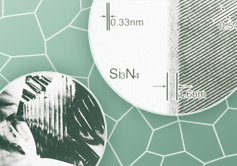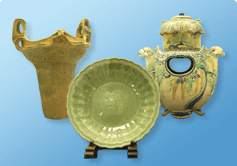Fine Ceramics, sometimes referred to as "advanced ceramics," are engineered materials that support the development of cutting-edge technology.
- HOME
- Introduction to Fine Ceramics
- Ceramics vs. Fine Ceramics
Ceramics vs. Fine Ceramics
Big Differences in Raw Materials and Production Processing
Ceramics are made from natural minerals; Fine Ceramics are made from highly refined raw materials.
Ceramic materials exhibit hardness, excellent heat and corrosion resistance, and electrical insulation properties. Typical examples include china, firebricks, cements and glass.
In addition to these properties, Fine Ceramics (also known as "advanced ceramics") have many advanced mechanical, electrical, electronic, magnetic, optical, chemical and biochemical characteristics. Today, Fine Ceramics have many roles in fields such as semiconductors, automobiless, telecommunications, industrial machinery and healthcare.
The physical differences between ceramics and Fine Ceramics mainly arise from their raw materials and manufacturing processes. Ceramics are manufactured by mixing, shaping and firing natural minerals including pottery stones, feldspar and clay. In contrast, Fine Ceramics are manufactured using highly purified natural raw materials, artificial raw materials synthesized through chemical processes and other non-naturally occurring compounds. Through a series of precisely controlled, complex processes such as forming, machining, firing and grinding, these compounded raw materials turn into high-value-added products with excellent dimensional accuracy and functional characteristics.
Classification of Ceramics
 Click item for details (below).
Click item for details (below).
Pottery & Ceramics
Pottery and ceramics are made by forming and firing raw materials including clay and pottery stones. They are divided into several categories, such as earthenware and porcelain, depending on such factors as raw material composition, firing temperatures and water absorption. Fine Ceramics are primarily composed of unique minerals such as alumina porcelain.
Earthenware

Includes clay biscuit vessels that are kneaded, shaped and fired at low temperatures (approx. 800℃ / 1,472℉). Typical examples include wares from Japan's Jomon Period (14,000 – 400 B.C.) and Yayoi Period (500 B.C. – 300 A.D.), as well as archaeological artifacts from the Middle East dating from around 6000 B.C. Modern uses include terracotta flowerpots, red bricks, stoves and water filters.
Pottery

Includes glazed ceramics fired at higher temperatures than earthenware (1,000 – 1,250℃ / 1,832 – 2,282℉), but which possess water absorption properties. Sue ware, Raku ware, Maiolica and Delftware are included in this family. Used in many modern products such as tea sets, tableware, vases and roof tiles.
Porcelain

Includes colorfully glazed, white ceramics hardened by forming and firing mixtures of high-purity clays (or pottery stones), silicas and feldspars. They were developed during China's Sui and Tang Dynasties (600 – 700 A.D.) and adopted worldwide. This family includes Jingdezhen ware, Arita ware and Seto ware. Widely used in modern tableware, insulators, arts & craftworks and exterior tiles.
Ceramics
Refractories

Able to withstand high temperatures: used in the construction of kilns for making iron, steel and glass.
Glass

Amorphous substance made by fusing and forming minerals such as silica, limestone and soda ash.
Cement

Fine powder made by mixing, firing and grinding minerals such as limestone and silica, which bind stone and sand through hydration to make concrete.
Fine Ceramics

Engineered materials with chemical compositions that are precisely adjusted using refined or synthesized raw powders and well-controlled methods of forming, sintering and processing. With higher levels of functionality compared to conventional ceramics, they are widely used in fields such as semiconductors, automobiless and industrial machinery. Fine Ceramics are also called new ceramics or advanced ceramics.
The term "Fine Ceramics" is interchangeable with "advanced ceramics," "technical ceramics" and "engineered ceramics." Use varies by region and industry.
People who read this page also read.

What are Fine Ceramics?
What are Fine Ceramics?
Term Coined by the Founder of Kyocera
Term Coined by the Founder of Kyocera
Introduction to Fine Ceramics

Fine Ceramics Use Highly Purified Raw Materials
Fine Ceramics Use Highly Purified Raw Materials
Raw Materials Need to Meet Demanding Performance Requirements
Raw Materials Need to Meet Demanding Performance Requirements
Introduction to Fine Ceramics

History of Fine Ceramics
History of Fine Ceramics
Rooted in Jomon Ware Used Over 10,000 Years Ago
Rooted in Jomon Ware Used Over 10,000 Years Ago
Introduction to Fine Ceramics

Four-Frame "Manga" Comics
Four-Frame "Manga" Comics
Easy to Watch, Touch and Understand Fine Ceramics
Easy to Watch, Touch and Understand Fine Ceramics
Four-Frame "Manga" Comics
If you want to use ceramics in business, click here.
Kyocera's Fine Ceramics products (All websites below open in a separate window.)
Product Category
 Semiconductor / LCD Processing Equipment
Semiconductor / LCD Processing Equipment
 Life / Culture / Industrial Machines
Life / Culture / Industrial Machines
 Wireless Communications
Wireless Communications
 Computer Peripherals
Computer Peripherals
 Environmental Preservation / Renewable Energy
Environmental Preservation / Renewable Energy
 Medical Equipment / Devices
Medical Equipment / Devices
 Single-Crystal Sapphire Products
Single-Crystal Sapphire Products
 Metallized / Vacuum Components
Metallized / Vacuum Components
 Electronics Industry
Electronics Industry
 Heaters
Heaters
 Piezoelectric Ceramics
Piezoelectric Ceramics
Search by Material
 Alumina
Alumina
 Silicon Nitride
Silicon Nitride
 Silicon Carbide
Silicon Carbide
 Sapphire
Sapphire
 Zirconia
Zirconia
 Cordierite
Cordierite
 Yttria
Yttria
 Aluminum Nitride
Aluminum Nitride
 Cermet
Cermet
 Mullite
Mullite
 Steatite
Steatite
 Forsterite
Forsterite
Search by Property/Characteristic


- Thermal Properties
- Coefficient of Thermal Expansion
- Thermal Conductivity
- Heat Shock Resistance

- Electrical Properties
- Insulation / Semiconductivity

- Chemical Properties
- Chemical Resistance









